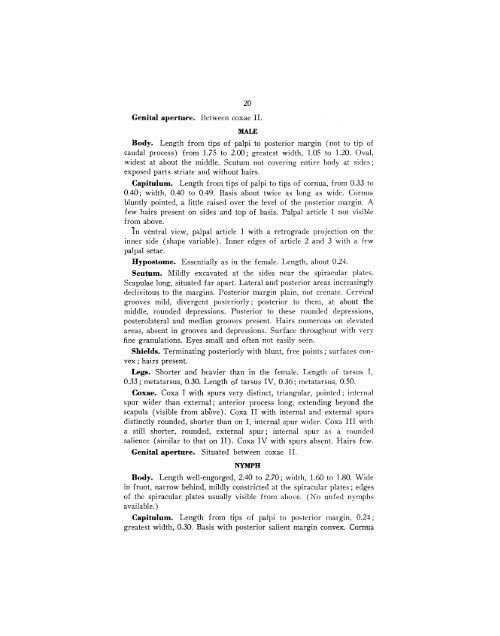The Genera Boophilus Rhipicephalus and Haemaphysalis (Ixodidae ...
The Genera Boophilus Rhipicephalus and Haemaphysalis (Ixodidae ...
The Genera Boophilus Rhipicephalus and Haemaphysalis (Ixodidae ...
You also want an ePaper? Increase the reach of your titles
YUMPU automatically turns print PDFs into web optimized ePapers that Google loves.
MALE<br />
Length from tips of palpi to posterior, margin (not to tip of<br />
Body.<br />
process) from 1.75 to 2.00; greatest width, 1.05 to 1.20. Oval,<br />
caudal<br />
at about the middle. Scutum not covering entire body at sides;<br />
widest<br />
parts striate <strong>and</strong> without hairs.<br />
exposed<br />
Length from tips of palpi to tips of cornua, from 0..33 to<br />
Capitulum.<br />
width, 0.40 to 0.49. Basis about twice as long as wide. Cornua<br />
0.40;<br />
pointed, a little raised over the level of the posterior margin..&<br />
bluntly<br />
hairs present on sides <strong>and</strong> top of basis. Palpal article 1 not visible<br />
few<br />
above.<br />
from<br />
setae.<br />
palpal<br />
Essentially as in the female. Length, about 0.24.<br />
Hypostome.<br />
to the margins. Posterior margin plain, not crenate. Cervical<br />
declivitous<br />
mild, divergent posteriorly; posterior to them, at about the<br />
grooves<br />
absent in grooves <strong>and</strong> depressions. Surface throughout with very<br />
areas,<br />
Eyes small <strong>and</strong> often not easily seen.<br />
granulations.<br />
Terminating posteriorly with blunt, free points; surfaces convex;<br />
Shields.<br />
hairs present.<br />
Shorter <strong>and</strong> heavier than in the female. Length ot tarsus I,<br />
Legs.<br />
metatarsus, 0.30. Length of tarsus IV, 0.:36; metatarsus, 0.50.<br />
0.323<br />
Coxa I with spurs very distinct, triangular, pointed; internal<br />
Goxae.<br />
wider than external; anterior process |ong, extending beyond the<br />
spur<br />
(visible from above). Coxa II with internal <strong>and</strong> external spurs<br />
scapula<br />
rounded, shorter than on I, internal spur wider. Coxa III with<br />
distinctly<br />
still shorter, rounded, external spur; internal spur as a<br />
roundel<br />
a<br />
(similar to that on II). Coxa IV with spurs absent. Hairs few.<br />
salience<br />
NYMPH<br />
Length well-engorged, 2.40 to 2.70; width, 1.60 to 1.80. Wide<br />
Body.<br />
front, narrow behind, mildly constricted at the spiracular plates; edges<br />
in<br />
the spiracular plates usually visible from above. (No unfed nymphs<br />
of<br />
available.)<br />
Length from tips of palpi to posterior margin, 0.24;<br />
Capitulum.<br />
20<br />
Genital aperture.<br />
Between coxae.II.<br />
ventral view, palpal article 1 with ]n retrograde projection on the<br />
a<br />
side (shape variable). Inner edges of article 2 <strong>and</strong> 3 with a few<br />
inner<br />
Mildly excaLcated at the sides near the spiracular plates.<br />
Seutum.<br />
long, situated far apart. Lateral <strong>and</strong> posterior areas increasingly<br />
Scapulae<br />
rounded depressions t:'osterior to these rounded depressions,<br />
middle,<br />
<strong>and</strong> median grooves present. Hairs numerous on elevated<br />
posterolateral<br />
fine<br />
Genital aperture. Situated between coxae II.<br />
greatest width, 0.30. Basis with posterior salient margin convex. Cornua

















